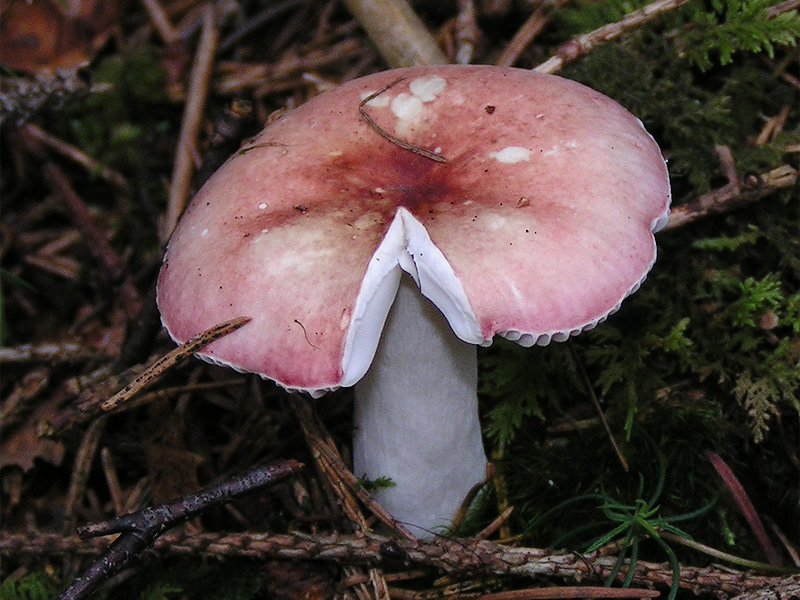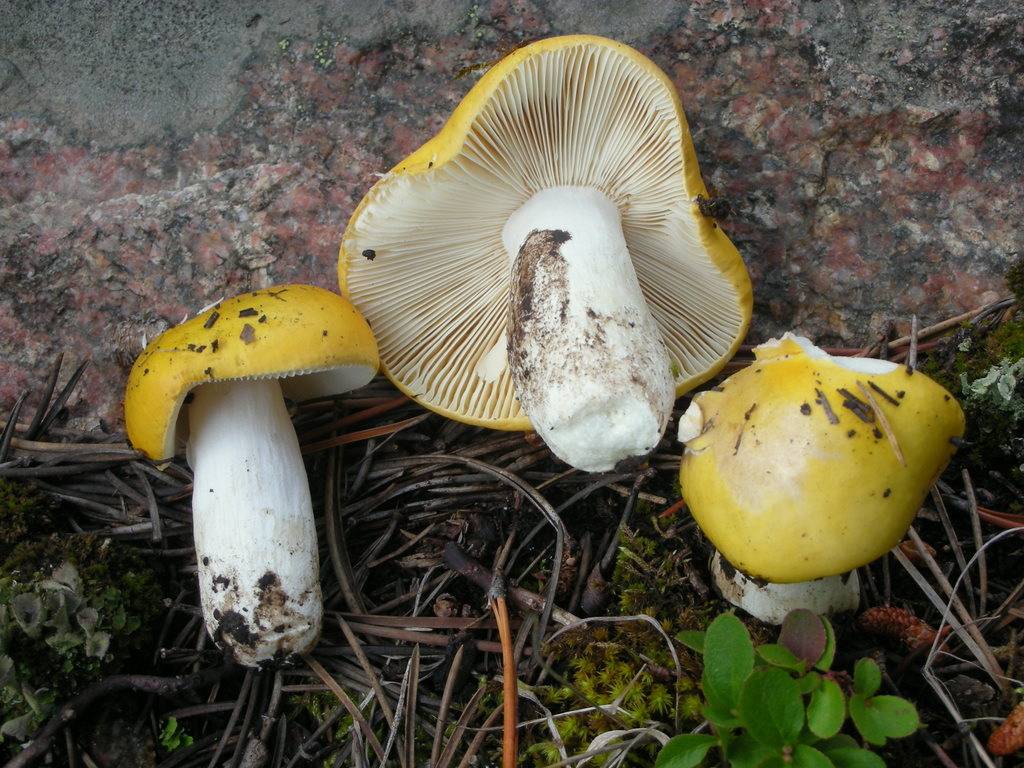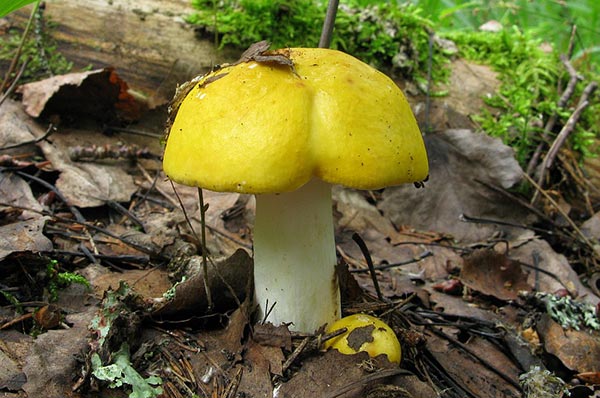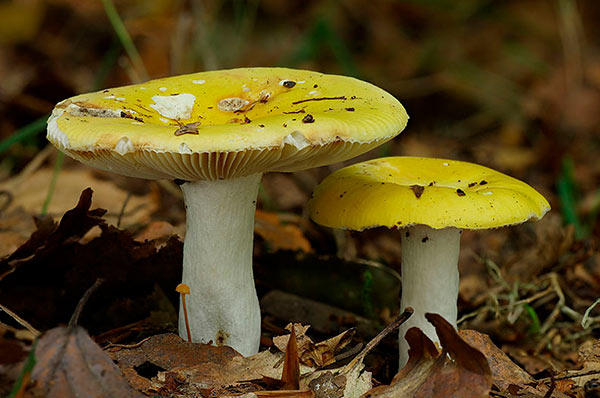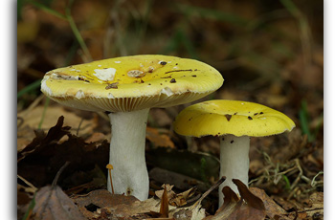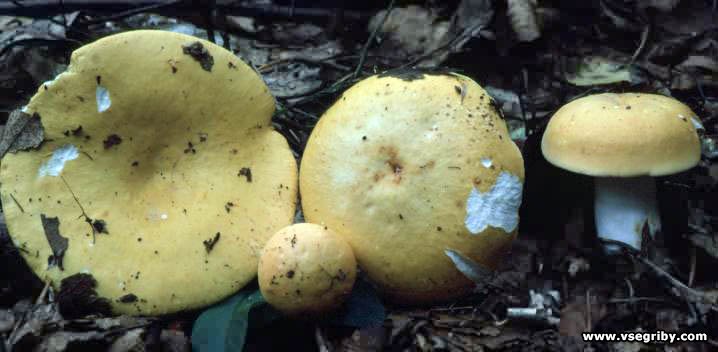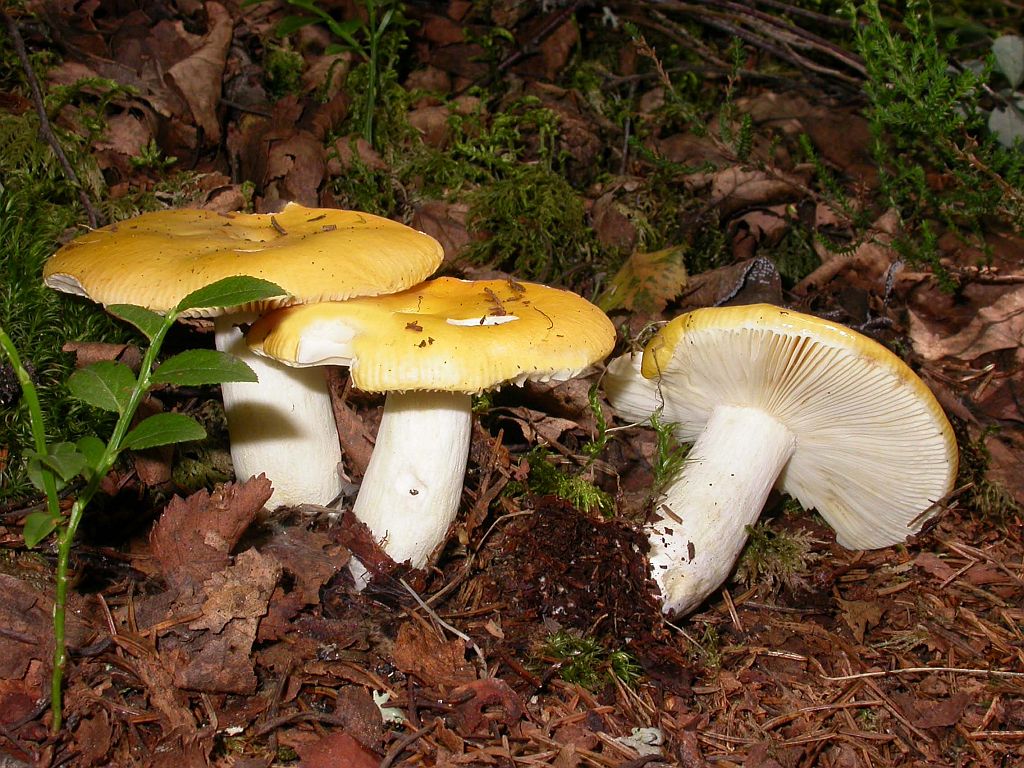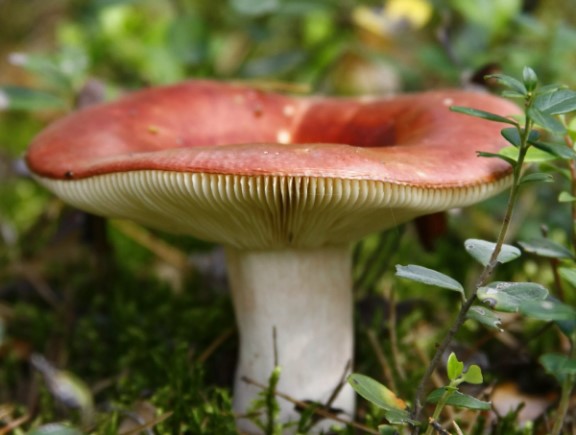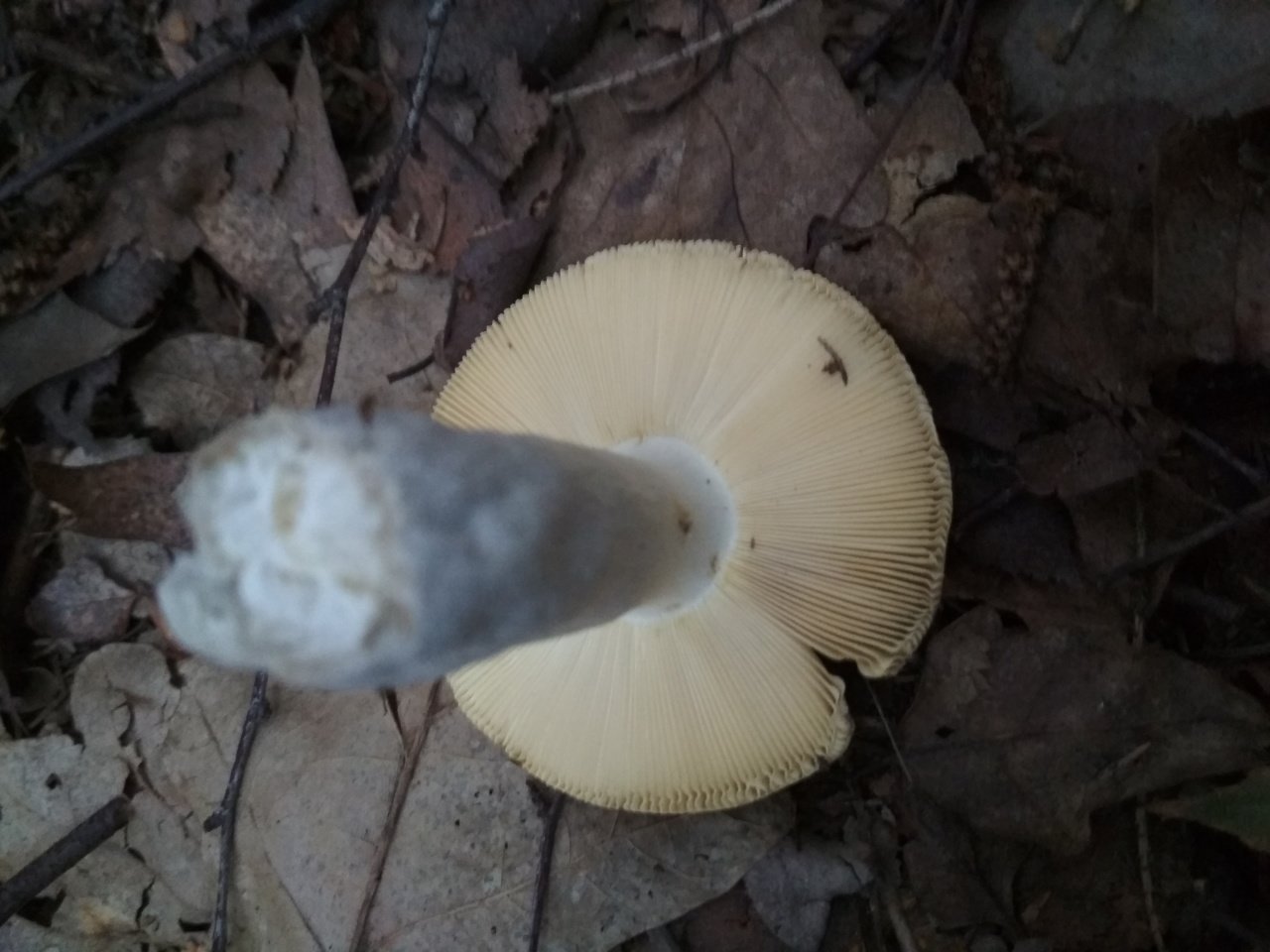Noticeable russula (Russula nobilis)
Other names:
- Russula fageticola;
- Russula fagetorum.
External description
The russula noticeable has a hat-pectus fruiting body, with dense white flesh, which may have a slightly reddish tint under the skin. The pulp of this mushroom is characterized by a pungent taste and aroma of honey or fruit. Upon contact with a solution of guaiacum, it intensively changes its color to a brighter one.
The cap of Mayr's russula is 3 to 9 cm in diameter, and has a hemispherical shape in young fruiting bodies. As the mushroom matures, it becomes flat, sometimes slightly convex or slightly depressed. The color of the cap in Mayr's russula is initially deep red, but gradually fades, becoming reddish-pink. The skin adheres tightly to the surface of the cap and can only be removed at the edges.
The leg of Mayr's russula is characterized by a cylindrical shape, very dense, often white in color, but at the base it can be brownish or yellowish. The fungal hymenophore is represented by the lamellar type. The plates in its composition at first have a whitish color, in mature fruiting bodies they become creamy, often grow with the edges to the surface of the leg.
Fungal spores in Mayr's russula are 6.5-8 * 5.5-6.5 microns in size, have a well-developed mesh. Their surface is covered with warts, and the shape is obovate.
Season and habitat of the mushroom
Mayr's russula are widespread throughout southern Europe. You can meet this species only in deciduous beech forests.
Edibility
The russula noticeable is considered a slightly poisonous, inedible mushroom. Many gourmets are repelled by the bitter taste of the pulp. When consumed raw, it can provoke not severe poisoning of the gastrointestinal tract.
Similar types and differences from them
Mayr's russula has several similar species:
1. Russula luteotacta - this type of mushroom can be found mainly in hornbeams. Distinctive features of the species are spores of a non-reticular structure, the pulp, which acquires a rich yellow color when damaged, weakly descending down the pedicle of the plate.
2. Russula emetica. This type of mushroom is found mainly in coniferous forests, has a rich color of the cap, the shape of which becomes funnel-shaped with age.
3. Russula persicina. This species grows mainly under beeches, and its main distinguishing features are cream-colored spore powder, reddish stem and yellowish plates in old mushrooms.
4. Russula rosea. This type of mushroom grows mainly in beech forests, has a pleasant taste and a reddish stem.
5. Russula rhodomelanea. This fungus grows under oak trees and is characterized by sparsely spaced blades. Its pulp turns black when the fruit body dries.
6. Russula grisescens. The fungus grows in coniferous forests, and its pulp turns gray upon contact with water or high humidity.
How to distinguish russula from doubles
The russula are very diverse and are a very difficult genus in terms of identifying and limiting species. The differences between species are sometimes very small, making it difficult to identify these fungi. Accurate determination can be made using microscopic features as well as chemical reactions. When determining, it is necessary to have specimens of the same species at different stages of development.
Most russula are edible mushrooms, mainly of the 3rd and 4th categories. The economic value of russula is reduced due to the fragility of the fruit chalk. Few of them are poisonous, inedible, or of no practical value.
Both in appearance and in their structure, all types of russules are in general very similar: the caps of young mushrooms are completely spherical, becoming a little funnel-shaped by old age. Almost all russula have white, even legs, white dense flesh in young mushrooms, becomes fragile, brittle, crumbly with age. Even if you carefully put the russula in the basket, you still risk bringing home only mushroom crumbs, and only the young, with the hat still unopened, remain intact.For this brittle pulp, russula, in general, cannot be confused with any other mushrooms.
Russula in foliage.
The russula is burning.
Valuiform russules.
From the name of these mushrooms, it might seem like they can be eaten raw. In fact, everything is quite the opposite, raw these mushrooms are a terrible pungent bitterness, and the name "russula" can be translated as "raw pungency", so as not to try and try them. But in salting and during heat treatment, the acridity of russula completely disappears.
Most mushroom pickers do not distinguish russula by name at all. For them russula is russula: red, yellow, lilac, pink, green. So do not worry if you suddenly failed to determine the type of this or that russula: they are all edible. There are no poisonous russules among the russules, there are only inedible ones because of their bitter or unpleasant taste. The main thing is to be able to distinguish between such inedible species - but most of them are marked with a red leg or an unpleasant odor.
A stinging inedible russula.
There are also mushrooms in the russula family, which some mistakenly classify as mushrooms, calling them dry mushrooms. These are loads. Indeed, they have a weight-like appearance, not a russula: large, dense, with a short stem, with curled edges of funnel-shaped caps, with plates descending to the stem. But one cannot fail to notice their main difference from milk mushrooms - this is the complete absence of milky juice. Therefore, these mushrooms are popularly called dry mushrooms, that is, not weeping.
The flesh of the cap is mostly white or very light in color; thick or thin; odorless or with a faint aroma and a different taste. When the fruiting body of the russula breaks, the milky juice is not released. The plates, pulp and legs of russula are very fragile. Fragility and fragility of these mushrooms is given by spherocysts - special groups of vesicular cells that are found in the fruiting body.
Several types of russula are called podgruzki, but most often two: white podgruzdok (Russula delica) and black podgruzdok (Russula adusta). The fruiting body of these mushrooms is formed underground, and when the fungus appears on the surface of the soil, there is always a lot of adhering debris on its cap. Loads, even very young ones, are often wormy. They grow in large groups, they love humus-rich soil.
Spore coloration is an important sign of russula. When determining russula, it is necessary to determine the color of the spore powder macroscopically in the mass. The color of the powder in different species ranges between pure white and intense yellow, with various transitions and shades.
Russula blue-yellow
Russula blue-yellow - Latin Russula cyanoxantha
In another way, the fungus is called blue-green russula.
Features of appearance
Mushroom cap
The blue-green russula is overgrown with rather large hats with a diameter of 50-160 mm. Young specimens appear with convex caps - hemispheres, the "headdresses" of grown mushrooms become flat, with pits in the middle.
The smooth hat surface stays dry on sunny days, becomes mucus-coated in wet weather and takes on a glossy appearance. It is painted in several shades at once, including gray - violet, blue - green, purple - pink and ocher. They all smoothly merge into each other.
The hats are filled with white, fragile flesh, lilac-red under the skin and does not change color when damaged.
The hat bottom contains many plates of a creamy shade growing to the legs, distinguished by their tenderness and flexibility: it is difficult to accidentally break them. When touched, they appear to be oiled.
The fungus reproduces by white spores.
Stipe
Young russula blue-yellow has a dense cylindrical leg, filled with cotton pulp and emptying at maturity. The legs grow about 10-30 mm thick and 50-100 mm long. They are white in color, often shaded with purple.
Russula blue-yellow - Latin Russula cyanoxantha
Growing places
These russula prefer areas with a temperate northern climate, grow both in the foothills and on the plains, in mixed, deciduous and coniferous forests with pine trees and acidic soil.
Group or single fruiting begins in early June and ends in early November.
Similar species
The mushroom has such edible counterparts:
- Gray russula. Has a gray-purple hat, white, with a pinkish tint, a leg and brittle white plates.
- Wine red russula. Her hats are painted wine red. The plates have a creamy gray color that darkens as the fungus ages.
- Whole russula. It features a brownish and scarlet hat and yellowish plates that become gray over time.
Edibility
Although the pulp does not exude a pronounced aroma, it has a pleasant nutty flavor. The blue-yellow russula is very tasty after frying or stewing, especially as a side dish for meat dishes, and mushroom soups. Young mushrooms are great for pickling and pickling.
This mushroom does not require pre-boiling.
Description of the edible mushroom
Light yellow russula (Latin name Russula claroflava) belongs to the genus russula of the russula family. This mushroom is sometimes also called pale yellow russula or simply yellow - as you can easily see, the unusual color of the cap gave the name to this species. The hat reaches 12 cm in diameter, the surface is shiny and dry, the skin is easily peeled off in half. The color can range from pale yellow to rich lemon and canary. The edge is most often even, sometimes ribbed, a couple of shades lighter than the central part. The hymenophore (the lower part of the cap) is lamellar, the plates are of medium frequency, almost free, brittle, white or yellowish, gray at the break. The pulp is even, dense, brittle, milky, and quickly turns gray and dark on the cut. Has a light pleasant floral or sweetish odor, taste - slightly pungent (in young mushrooms), not pungent. The stem is dense, cylindrical in shape, usually even, but specimens with a curved stem are found. The color is white; as the fruiting body matures, it acquires a dirty grayish tint. Its height is on average 3-6 cm, diameter is 1-2 cm.
Russula golden
| Group: | Lamellar |
|---|---|
| Plates: | White, yellowish |
| Colour: | Shades of red |
| Info: | Scales on the leg |
| Department: | Basidiomycota (Basidiomycetes) |
|---|---|
| Subdivision: | Agaricomycotina (Agaricomycetes) |
| Class: | Agaricomycetes (Agaricomycetes) |
| Subclass: | Incertae sedis (indefinite) |
| Order: | Russulales |
| Family: | Russulaceae (russula) |
| Genus: | Russula (Russula) |
| View: | Russula aurea (Russula golden) |
The mushroom is edible, assigned to the 3rd category, has a pleasant taste. It is appreciated above most types of russula. You can use it fresh or salted.
Description
Russula golden received its specific name due to the clear yellow subtone of the color of the entire fruit body.
Hat
The size of the cap varies from 4 to 9 cm in diameter. With maturation, its shape changes from hemispherical to flat and then centrally depressed. Young specimens have smooth edges, and old ones are striated (a layer of hymenophore appears).
The color of the cap is of all shades of red, and at a young age, red color predominates in mushrooms of this species, and yellowness appears more and more in maturity. The central cap is almost always colored in shades of yellow. The surface is variable to the touch depending on humidity: in the absence of precipitation - dry, in rainy weather - sticky.
Leg
The russula golden has an even-cylindrical stem with a rough-scaly surface. The leg is painted white, sometimes yellowish, and turns brown in mature mushrooms. Inside, the leg never contains a cavity and has a cotton-like consistency. In mature mushrooms, it acquires a distinct porosity. The dimensions of the leg are from 3 to 8 cm in height and from 1 to 2 cm in thickness.
Spore powder
The spores are egg-shaped and fairly large. Their surface is bumpy and reticulate. The bulk of the spore powder is white.
Spore-bearing layer
The plates are of moderate thickness, can be located both often and not very much. Multiple bifurcation of the plates is usually observed. Their color is initially white, but in the process of maturation it quickly turns yellow. The plates are not attached to the leg.
Pulp
Initially hard and crumbly, in mature specimens it becomes softened and “wadded”. Directly under the easily detachable skin of the cap, the flesh is yellow, and in the rest of the mushroom it is white. The pulp does not emit any smell and has a pleasant sweet taste.
Distribution and collection
The golden russula, with a fairly widespread prevalence (practically over the entire Eurasian and North American territory), is not very common. This species grows mainly in deciduous forests all summer and the first month of autumn.
Similar species
There are several types of russula, resembling golden in appearance:
This mushroom has a very strong pulp and red shades of the cap, which do not turn yellow with age. The pulp has a distinctly fruity smell, and when heat-treated it is turpentine, and therefore the species is not considered edible. This species is found in all types of forests.
On the cut, it changes color to gray, grows more often in swampy areas, is edible.
Buffy russula
It is similar to the previous one (yellow), but higher in gastronomic quality, does not turn gray on the cut and grows in dry places.
Russula golden yellow
It is edible and smells like flowers, this smell is enhanced by heat treatment. The mushroom has a bright yellow coloration of the plates and a cap without redness.
Russula solar
Inedible, has a yellow cap without redness. The taste of this mushroom is pungent, and the smell is mustard. It is usually found next to oak trees.
Acetic russula
It has a red cap and emits a pronounced vinegar smell, its edibility is controversial.
Edibility
The golden russula is edible and delicious. It is sweetish and does not have foreign odors, which makes it suitable for use in any mushroom dishes.
Interesting Facts
Like the rest of the russula, the golden russula should not be eaten raw. The name does not reflect this aspect at all, but the fact that these mushrooms take much less time to cook than other mushrooms.
It is found infrequently (although almost everywhere) and is a rather successful find due to its good taste. It can be confused with some inedible russula species, so you should focus on specific distinctive features.
False poisonous doubles
There are not so many false doubles in the light yellow russula, and it is easy to distinguish them from the edible mushroom. The only poisonous species that can be confused with is the green form of the Amanita Phalloides, also known as the green fly agaric. Yellow mushrooms similar to russula:
| Yellow russula
|
Death cap
|
|
| Hat | light or bright yellow, convex-outstretched, most often depressed towards the middle | dirty green tone, dome-shaped or convex-spreading |
| Leg color | white or grayish, no pattern | dirty gray color scheme with moire pattern |
| Skirt | No | there is |
| Smell | light, pleasant sweetish or floral | repulsive, similar to the smell of raw potatoes |
| Pulp | fragile | flexible |
| Does it get dark at the break | Yes | No |
Evaluation of taste, primary processing and recipes for the preparation of the mushroom
The russula with a bright yellow cap belongs to the third category of mushrooms, that is, it is a good edible fruiting body. It has a pleasant taste, although it is less valued than other members of this family. There are many options for its preparation:
salting: the mushrooms are washed and cut into large pieces or left intact, poured with brine (2 tablespoons of salt per liter of water), adding a little peppercorns, dill and black currant leaves.You can also add other spices and herbs to your taste. After a day in such a solution, russula are ready for use: season them with vegetable oil and garlic and boldly serve them to the table;
pickling. The recipe is the same as for salting, except that vinegar is added to the brine. This method can be used for long-term preservation, and for fast: russula marinated in this way can be eaten the next day;
cooking. This mushroom is boiled for about 10-15 minutes in two waters: in the first it is brought to a boil and kept for several minutes, then transferred to another container with boiling water and the time remaining until readiness is cooked there.
Please note that after boiling, the flesh of the mushroom will darken. You can pre-soak the mushrooms in cold water for several hours, but this procedure is completely optional;
frying
The russula are fried in vegetable oil until their characteristic golden hue appears. Be careful as these mushrooms cook very quickly.
Description
Buffy russula (Russula ochroleuca) most often belongs to the category of inedible, but some experts consider it conditionally edible. Synonymous names are lemon russula, pale ocher russula, as well as pale yellow, ocher yellow, ocher yellow and ocher white.
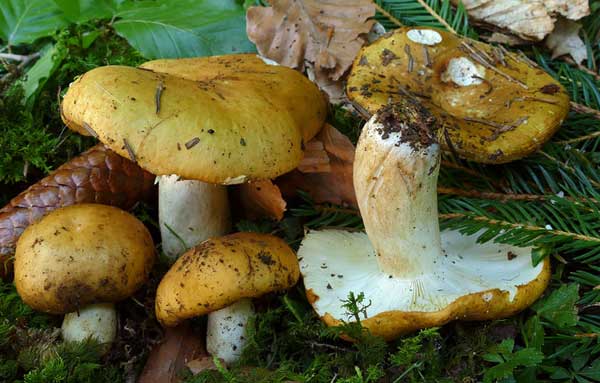
The species has the following features:
- the cap is painted in an ocher-yellow color of varying intensity, sometimes with greenish tints, in the center it is darker, closer to brown. In the early stages of development, it is convex, hemispherical with curved edges, gradually opening up to flat, depressed in the center. The skin is matte, dry, can be easily removed in long strips, with high humidity it becomes somewhat mucous. The diameter of the cap is from 5 to 12 cm;
- White and light creamy plates are relatively frequent, narrowly adherent;
- spores are white;
- the cylindrical stalk in the early stages of growth is white, then grayish-yellow. Length from 3 to 9 cm, diameter - from 1 to 2.5 cm;
- the flesh is whitish, fragile, odorless, has a more or less pronounced peppery taste.
Description of yellow russula
It is very easy to spot the yellow russula in the forest due to its bright yellow color of the cap. The shape of the cap is hemispherical, with time it becomes almost flat, and in older specimens it becomes funnel-shaped. The diameter of the cap of the yellow russula is 5-10 centimeters.

Its surface is dry and smooth. The skin is peeled off along the edge of the cap. Initially, the edges are slightly wrapped, and then they become smooth and dull. The cap is covered with a sticky, shiny skin that can be removed about halfway.
The leg is always white, never reddish, at the base it is grayish. It is cylindrical and even in shape. The structure of the leg is dense.
The plates are white, then they become pale yellow, and with aging or damage they turn gray. The pulp is not pungent, firm, white in color, most often gray in the air. The pulp has a weak floral smell, and the taste can be sweet or pungent. At the break, the pulp turns gray, and then blackens. Spore powder, buffy, Spores are prickly, ovoid, with a well-visible mesh.

Growing places of yellow russula
They grow in damp birch and pine-birch forests. You can find these mushrooms in moss and on the outskirts of swamps. They are most often found in the northern forest regions. Yellow russula settle in small groups.
Assessment of yellow russula
These are edible mushrooms, they belong to the 3rd category. It is recommended to collect young fruit bodies, which still have firm pulp. Yellow russula can be used fresh, as well as salt. These mushrooms have a pleasant taste, but they are less valued than russula of other species.
Similar species
Outwardly, the yellow russula is similar to the ocher russula, but the latter grows in drier places, meeting under deciduous and coniferous trees. The ocher russula has a sharper taste, and the plates are lighter. If the russula is damaged, the ocher ones do not turn gray.

The ocher russula is also called pale yellow, ocher white and lemon. It is the most famous species of russula and is found in many temperate forests. The diameter of the ocher russula cap is 6-10 centimeters. At first, its shape resembles a hemisphere with curved edges, then it becomes prostrate and slightly depressed. The surface of the cap is dry, dull; during the rainy season, it becomes covered with mucus. The color of the cap is yellow ocher. The skin is detached from the edges of the cap. Her leg is dense, long and thin. The surface of the leg may be wrinkled. The color of the legs is white, and sometimes yellow.
Buffy russula bear fruit from August to October. Favorite growing areas are spruce and deciduous forests, with a good level of moisture. These mushrooms grow in the forest floor and in mosses. In the southern parts of the country, ocher russula are rare.
Buffy russula are eaten, according to their taste, they belong to the 3rd category. In some sources, they appear as conditionally edible and even inedible. Before eating, ocher russules are pre-boiled.

The russula is fragile. Related species
The russula does not have a fragile double with which it can be confused. But there are species related to it that have similar external characteristics, but different biological characteristics and belong to different gastronomic groups. How to distinguish russula brittle?
Russula sardonyx
Russula sardonyx (limon-lamellar) - Russula sardonia. Hat: convex or flattened. Color: deep purple, wine-purple or red-brown, sometimes with greenish-yellow and yellow-brown tints.
The plates are densely arranged, fit tightly or descend on the pedicle. The color in young specimens is lemon-cream, in mature mushrooms it is bright yellow.
The stem is cylindrical, smooth, spongy. The color is the same tone as the hat, with a purple or purple tint.
The pulp is strong. Yellow color. Smell: fruity, pungent. The taste is pungent, bitter. The mushroom is poisonous.
Russula sardonyx is found in Europe in mixed and coniferous forests. Grows under the pines.
Turkish russula
Turkish russula - Rússula túrci. Hat: convex or depressed. It differs from the russula in its fragile lack of dark pigmentation in the center of the cap. The color remains deep purple throughout the life of the fungus.
The plates are light beige and never white. The leg is cylindrical. Color: white or pink.
Despite the specific smell of iodoform, which cannot be eliminated during processing, the Turkish russula has a rather good taste and belongs to the group of conditionally edible mushrooms. It does not cause poisoning when consumed.
Distributed in Europe. It grows under spruce and fir trees, forming large groups.
Russula blue-yellow
Russula blue-yellow - Russula cyanoxantha. The mushroom is large. Hat - 15 cm. Color: greenish-brown, violet-gray. Leg - 12 cm.
The blue-yellow russula, unlike the russula, is brittle, does not have bitterness, in Europe it is considered a delicacy.
Death cap
Sometimes, for a number of reasons, the brittle russula cap becomes light, greenish-gray, which makes it look like a pale toadstool (Amanita phalloides) - a deadly poisonous mushroom. Distinctive features are the absence of a ring and a swollen base with a brittle volva in a russula.
Similar species
The inedible, and in some sources conditionally edible ocher russula (Russula ochroleuca) with a color of a similar tonality looks like a light yellow one. Its main differences are settling in drier, sufficiently drained places, including in a coniferous forest, a slightly pungent taste, light plates and pulp that does not gray when damaged.
Similar in tone, but much lighter species Russula raoultii and Russula risigallina are found much further south, mainly in Central European forests, and the whitish-yellow Russula solaris with a bitter taste grows exclusively under beech.

